#Nc native plants
Text

Bernard Stark’s new habitat is blooming 😍
The cardinal flower I transplanted in early spring is much happier in this spot where it gets more shade than sun.
0 notes
Text

Sarracenia alata / Pale Pitcher Plant at the Sarah P. Duke Gardens at Duke University in Durham, NC
#Sarracenia alata#Sarracenia#Pale Pitcher Plant#Yellow trumpets#Pale trumpet#Pitcher Plant#Pitcher Plants#Native plants#Carnivorous Plants#Nature photography#photographers on tumblr#Sarah P. Duke Gardens#Duke Gardens#Duke University#Durham#Durham NC#North Carolina
81 notes
·
View notes
Text

#trillium#native plants#toadshade#spring flowers#nature photography#photographers on tumblr#nc mountains
14 notes
·
View notes
Text
WHY has the nc native plants society gotta be full of ASSHOLES???
Like I would love to be involved with them but every interaction I've ever had with them has been SO GODDAMN UNPLEASANT THE PEOPLE THERE ARE SO GODDAMN RUDE FOR NO REASON??
2 notes
·
View notes
Text
Checking out Venus Flytraps in their NATIVE habitat
Come with us as we look for the animal eating carnivorous plants in their Native habitat at Carolina Beach State Park - Venus Fly Traps, Pitcher Plants, and Sundews. We come across many other wonderous animals on our hike through the swampy area.
Come with us as we look for the animal eating carnivorous plants in their Native habitat at Carolina Beach State Park – Venus Fly Traps, Pitcher Plants, and Sundews. We come across many other wonderous animals on our hike through the swampy area.
Learn more in the video by Epic Earth YouTube:
Carolina Beach State Park Carnivorous Plants, North Carolina
More about this subject

View On WordPress
#carnivorous plant habit#carnivorous plants#Checking out Venus Flytraps in their NATIVE habitat#pitcher plant#sundews#Venus flytrap#Venus flytrap NC#Venus flytrap north carolina
0 notes
Note
Oh venus fly traps are very cool, they live / exist in a very (very very very very very) small area of north/south carolina (Its like a 60 mile radius of Wilmington NC) now a days its slightly larger but not really, theres a bog/swamp in florida that has a naturalized group of them but yeah the original range is the costal swamps of North/ South Carolina. Which is why they evolved to be carnivorous plants due to lack of nitrogen in the soil! They still get pollinated their flower is just like way above it! They can also become un-carnivorous if someone owns it and has too much nitrogen itll stop eating insects but still grow the traps because those functionally are like leaves, they grow new ones as needed!
They also NEED FIRE! Its the only way its seeds germinate!
Theyre also ENDANGERED! Theres roughly 300,000 (per a survey in 2019) of them in its native area. Which from the last full survey of them back in 1979 which said theres about 4,500,000 of them thats a 93% REDUCTION of their population. and the areas that it now populates only 21/70 sites they are found point towards being viable for the future.
Im just very passionate about venus fly traps, i have lots of family from north carolina so things from there are special to me. ❤️
Whawhawhaaat!!! Man, this is awesome! Thank you so much anon, I don't know much anything about venus flytraps but now I do! In my mind, venus flytraps were sort of like a fictional plant, even though I knew they were real as I've seen them for myself, they're just so... I don't know how to say it. Intangible, often talked about separately from the world we inhabit? I never knew where they actually grew, or if they're flowering plants, or that they need fire to germinate their seeds!!! Like, that's a real plant! Now that this connection to the places and ecosystems it inhabits has been established in my mind does it actually become cooler :D
How sad that they are endangered though! Must be a combination of habitat loss and perhaps overharvesting, since they are popular plants and probably popular to own too :/ I hope that there are protective measures taken to conserve this unique plant and its valuable ecosystem; coastal swamps and wetlands in general are so important! At the end of the day raising awareness is very important and that's what you did anon, thank you again :)
81 notes
·
View notes
Text

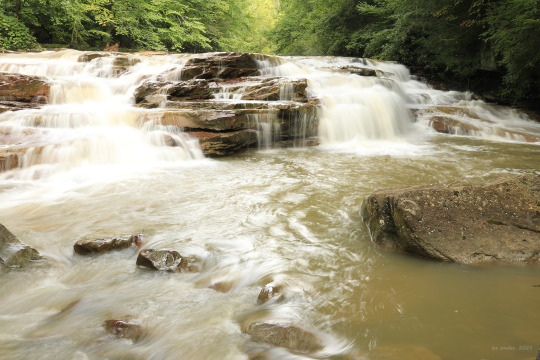


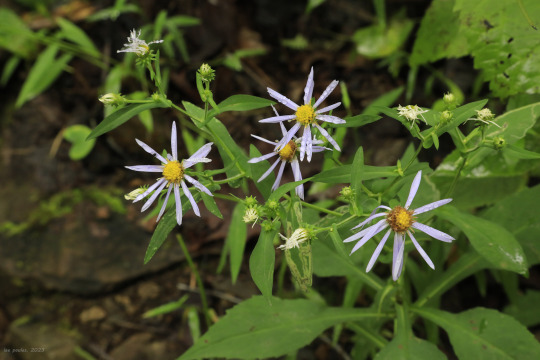
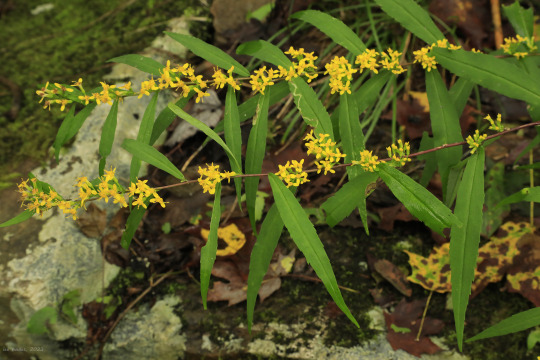
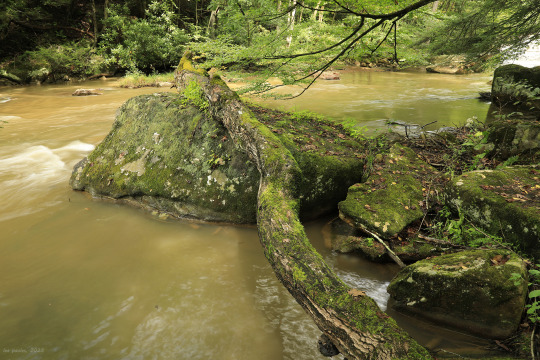
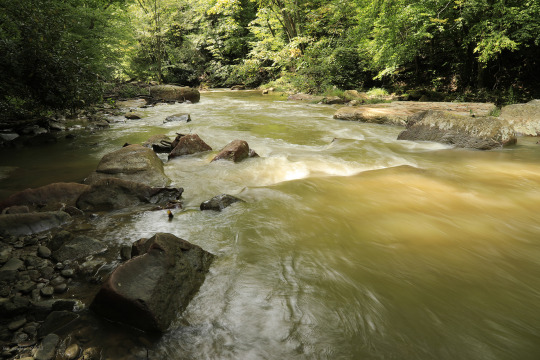
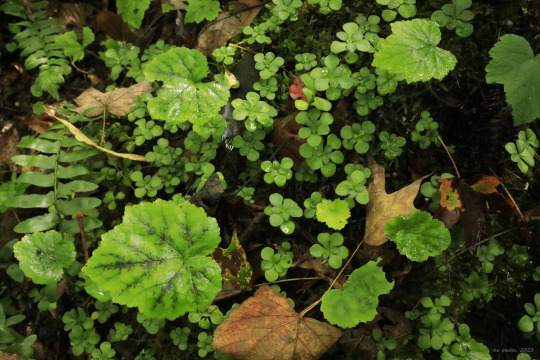

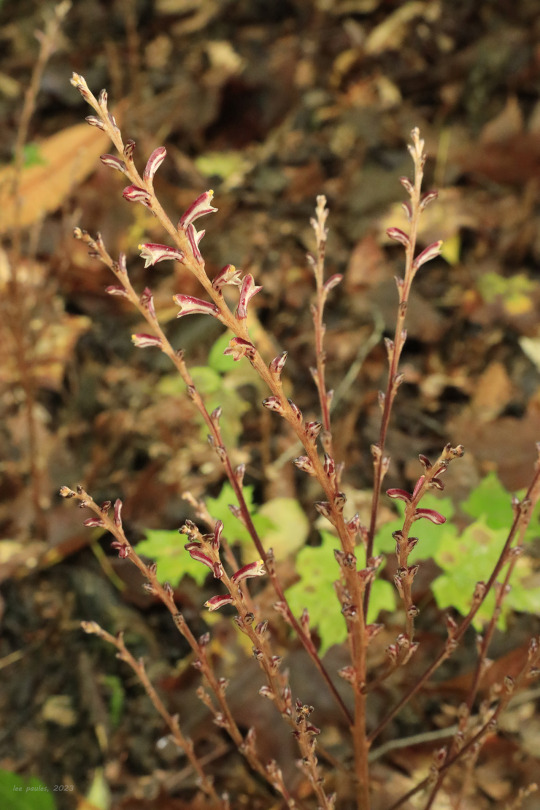
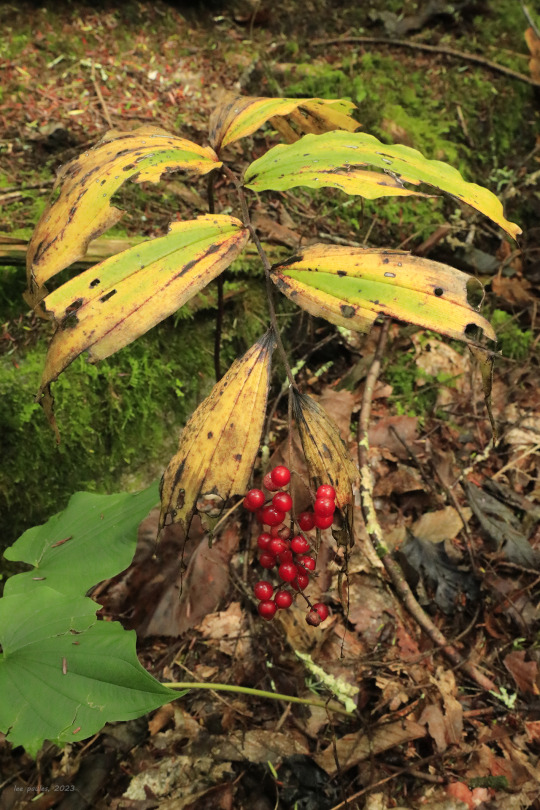
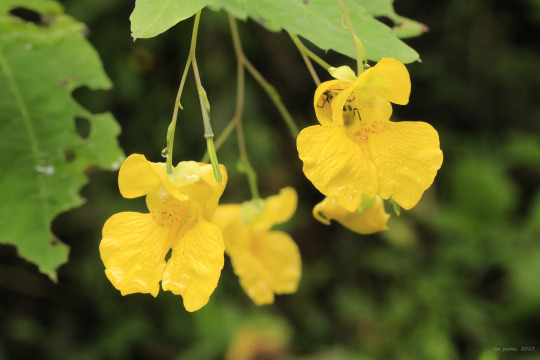
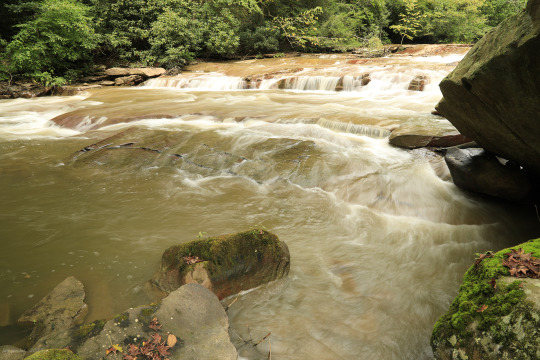

Despite its undignified name, Muddy Creek is a lovely mountain stream that normally runs fast and clear on its steep descent to Cheat River. But after a week of heavy rain in NC-WV, the stream looked a bit murky yesterday. Not even the sediment washing away from the mountains dims its beauty in my eyes. And the enchanting, moss-encrusted forest along its bank holds its own late summer treasures.
From top: great blue lobelia (Lobelia siphilitica), which pairs beautifully with cardinal flower to provide late summer color in a native wildflower garden; white wood aster (Eurybia divaricata), which is the most common of the shade-loving white asters in this area; crooked-stemmed aster (Symphyotrichum prenanthoides), also known as zigzag aster, whose clasping, spatula-shaped leaves distinguish it from big-leaf aster, another woods-loving aster with lavender flowers; blue-stemmed goldenrod (Solidago caesia), whose spreading, yellow-flowered stems provide stunning late-season color in a native wildflower garden; an intensely-green collage of moss, woodland stonecrop (Sedum ternatum), Christmas fern (Polystichum acrostichoides) and heartleaf foamflower (Tiarella cordifolia), which I am trying hard to reproduce in my own native wildflower shade garden; the shaggy-maned stem of Coker's Amanita (Amanita cokeri), one of the most impressive mushrooms of Appalachia's summer forests; beech-drops (Epifagus virginiana), a parasitic plant that grows and subsists on beach tree roots; the bright red berries of false Solomon's seal (Maianthemum racemosum); yellow jewelweed (Impatiens pallida), whose explosive seed pods give the plant its other common name, pale touch-me-not; and narrow-leaved tick-trefoil (Desmodium paniculatum), also known as panicled tick-trefoil, a late summer pea whose sticky seed pods commonly hitch rides on shoes and boots.
#appalachia#vandalia#west virginia#wildflowers#flora#summer#muddy creek#cheat river#preston county#fungi#coker's amanita#great blue lobelia#white wood aster#crooked-stemmed aster#zigzag aster#blue stemmed goldenrod#woodland stonecrop#christmas fern#heartleaf foamflower#beech-drops#beech drops#false solomon's seal#solomon's plume#yellow jewelweed#pale touch-me-not#narrow-leaved tick-trefoil#panicled tick-trefoil#falls#rapids#mountain stream
103 notes
·
View notes
Note

Saw this guy in my backyard plant closed terrarium and it doesn't look like any of the other isopods in there! An interesting little guy for sure. Collected in central NC if that'd help with identification (though it's probably not native)
Armadillidium vulgare
54 notes
·
View notes
Photo


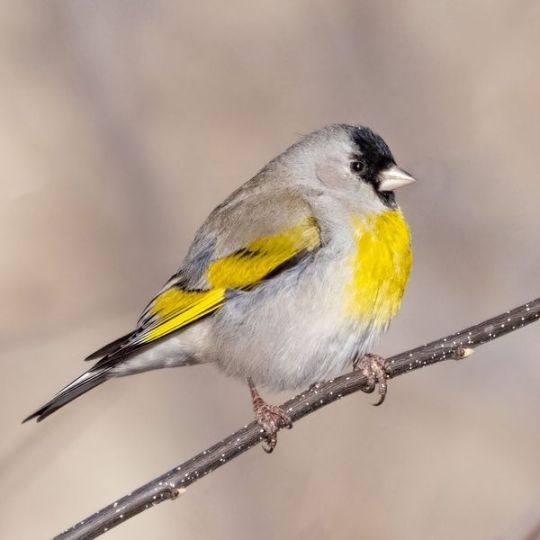
Do you know your American goldfinches?
We don't just mean the American goldfinch, though he's very dapper. North America also has two other species of goldfinch, the lesser (that's not a value judgment) and Lawrence's.
All three are common feeder visitors where they live.
1. American goldfinches can be seen across the lower 48 states. They especially love to eat the seeds of native plants like swamp thistle or Maximillian sunflowers. You might hear them call out "po-ta-to chip."
2. Lesser goldfinches are the smallest of the three and have a bright yellow underside with black on their upper parts. They can be seen throughout the Southwest, from California to Texas.
3. Lawrence's goldfinches are desert dwellers, living in arid parts of California, Arizona, and New Mexico. They have gray bodies with yellow wings and chest, and a black face. These are the goldfinches that might be most difficult to spot.
Photos: all by Mick Thompson, CC BY-NC 2.0 flic.kr/ps/XdAys
via: U.S. Fish and Wildlife Service
23 notes
·
View notes
Note
Got a friend starting a garden at their home in eastern NC, hoping to go wild with native plants and minimal lawn grass but dealing with a strict HOA.
Any ideas I can pass along?
Add flowerbeds until you have more flowerbed than lawn. Dense flowerbeds packed with so much stuff you couldn't tell at first glance if it's "weedy" or not. Pinterest actually has some great ideas for how to make a gorgeous looking "native plant garden" that is natural but still looks nice and neat.
A single patch of native plants and flowers is enormously beneficial to wild creatures. It's not about the surface area alone.
If there's room and you're allowed, a little grove of trees is a great idea. You can eventually seed shade-loving wildflowers underneath and it will look like heaven if you're willing to wait 10 years.
So, all these plants depend on HOW east you are, but: Sweetgum drops seed pods, but it is an awesome tree for wildlife. Our native red mulberry feeds at least 30 bird species and people too, but it is an understory tree that likes shade so it's not step one.
Red maples are good, but they're a common tree already in suburban areas. Tulip poplar is a host plant for the tiger swallowtail butterfly. I highly recommend an oak—oaks are considered keystone species. Best practice is to find out precisely what ecoregion you're in, work out how close you are to waterways, and from there reconstruct the kind of habitat the yard would like to be.
Shrubs...native shrubs are not appreciated enough. I think trying staghorn sumac, Virginia sweetspire, spicebush, Arrow-wood viburnum, and/or red-osier dogwood could be good?
It's a great idea to build a pergola that you can grow vines on.
106 notes
·
View notes
Text
While we were at the beach, my sister bought a venus fly trap from a man who is VERY passionate about venus fly traps, and a fun fact I learned is
They are only native to the place where we go to the beach! They are from about a 60 mile radius from Wilmington, NC! I feel like they are so famous but they only grow in one teeny tiny place in the world! And that place is my favorite place! Absolutely astounding to me! Also each little branch can only close about three times before it dies so do NOT put something in there to try to make it snap shut! You'll kill your plant!
Also you have to be licensed to sell them in NC and you should only buy ones that are 5 years old or older! ALSO if you have one, they often go dormant in the winter so if yours dies in the winter don't trash it! just keep it warm and swampy and it will come back to life probably in the spring.
14 notes
·
View notes
Text
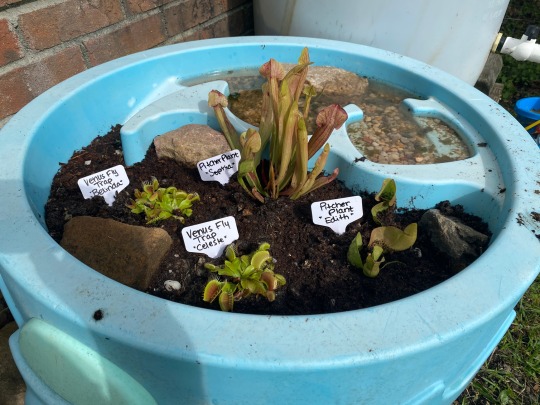
Celeste, Belinda, and Sophia have joined Edith in her new digs.
0 notes
Text

Sarracenia leucophylla / Crimson Pitcher Plant at the Sarah P. Duke Gardens at Duke University in Durham, NC
#Sarracenia leucophylla#Sarracenia#Sarraceniaceae#Crimson pitcherplant#Pitcherplant#Pitcher plant#Crimson Pitcher Plant#pitcher plants#carnivorous plants#Native plants#nature photography#photographers on tumblr#Sarah P. Duke Gardens#Duke Gardens#Duke University#Durham#Durham NC#North Carolina
37 notes
·
View notes
Text
Wildcrafting Mistletoe, or harvesting it from the wild, can be a little tricky considering the height at which it grows. Bottom line, all plants collected for spiritual purposes should be approached with reverence and great care. I mean, duh, right? So for the love of all things holy, please don’t shoot the mistletoe out of the tree with a shotgun.
Finding and Harvesting Mistletoe
Once the leaves fall from the deciduous trees in winter, it is easy to find see the Mistletoe growing in large clumps among the branches. I live in Eastern, North Carolina and it is EVERYWHERE, once you know what to look for. The problem with wildcrafting this herb for magickal and ritual uses isn’t its availability, but its accessibility. When climbing the tree isn’t possible, and the ladder won’t reach, folks around here get creative.
My dad was raised in Alabama and Kentucky, and he tells me it is common country-boy practice to take your shotgun out into the woods and shoot the mistletoe out of the branches. I even found this article bragging about just such a 12-guage shotgun hunt in NC. I’m a city witch, so I wouldn’t have guessed this to be something a magickal person would think to do. Then I met a witch peddling freshly blasted mistletoe. <headdesk>
Um, no. Just….no. Trust me.
How did the ancient Druids collect Mistletoe?
Pliny the Elder, a first century Roman historian, described the ceremony of collecting mistletoe in his Natural History XVI:
“Mistletoe is rare and when found it is gathered with great ceremony, and particularly on the sixth day of the moon….Hailing the moon in a native word that means ‘healing all things,’ they prepare a ritual sacrifice and banquet beneath a tree and bring up two white bulls, whose horns are bound for the first time on this occasion. A priest arrayed in white vestments climbs the tree and, with a golden sickle, cuts down the mistletoe, which is caught in a white cloak. Then finally they kill the victims, praying to a god to render his gift propitious to those on whom he has bestowed it.” Witchipedia
Avoid Damaging the Tree
I asked around the Patheos author forum for input on this question of Harvest-by-Shotgun, and John Beckett, Druid, author and blogger at Under the Ancient Oaks had this to say:
“From a magical and spiritual perspective, it’s not a good idea [to shoot down mistletoe]. People use a shotgun because it’s easy – you don’t have to hit the mistletoe exactly (as with a rifle). But that means you don’t just shoot down the mistletoe, you also shoot the tree. So you’re not just detaching the mistletoe from the tree, you’re also damaging the tree – and likely mangling what mistletoe you shoot down. None of which is likely to preserve the magical properties of mistletoe, much less establish good relations with your local nature spirits.”
In witchery we regard trees to be the priests of the plant realm, so I think one can assume that assaulting a tree with a deadly weapon isn’t a great way to begin your partnership. That isn’t magick; that’s a mugging. Then consider the spirit of the Mistletoe whom you hope will work to aid you. Introducing yourself via GSW* hardly seems neighborly. I shudder to think how the Dryad, the nymph of an oak tree, might take umbrage and retaliate! Good luck with that.
*GSW = Gun Shot Wound, for those who don’t watch police and legal procedural shows as much as I do. <snark>
Avoid Iron
Morgan Daimler, Author and Patheos Agora Blogger on Irish American Witchcraft, reminded me of the “old belief that you shouldn’t cut a plant for magical purposes with iron because that would drive out its spirit.“ Assuming there is some iron or steel in the shot, that would be counter-productive at least. I don’t know any modern pagans wielding golden sickles (as Pliny described); however, there are more common non-ferrous metals, including aluminum, copper, zinc, brass, gilding metal and tin. I have pair of aluminum gardening sheers for magickal harvesting that serve my purposes just fine.
Don’t Let it Hit the Ground
Moreover, to remain effective, Mistletoe should never be allowed to touch the ground, hence the Gaulish Druid’s practice of catching it in a white cloak.
Chris Godwin, Patheos blogger at From a Common Well, offered this input: “In British Magical practice, you address herbs as allies, with reverence and reference to their lore. Gaelic magic doesn’t seem to be of much difference. Also, Mistletoe is sacred in systems like trolldom because they’re liminal, they don’t grow on the ground, but in the sky. So if the mistletoe hits the ground, it loses its liminality and potency.”
So, unless a shooter has a partner in crime who is brave enough to stand UNDER where they’re blasting and can catch it as it falls willy-nilly, you’ve foiled your magick before you’ve begun. All these shenanigans sounds stupidly dangerous, too.
Mistletoe is a helpful Parasite:
Just for interest, how does the Mistletoe get all the way up there? Mistletoe spreads among the heights of trees when birds eat the sticky white berries and then poop them out on branches. Ahhh, the circle of life. There is a good lesson here about how excellent things can emerge from shit. Thanks birdies!
These evergreen plants are able to grow high up in the branches of trees by jabbing a special type of root called a haustorium into the host plant to suck out water and nutrients from it. Despite their parasitic means of growth, scientific studies have found that the presence of mistletoe plants actually improve the biodiversity around them. (Biology Bytes ) They never touch the earth, which is why they are especially magickal plants associated with air.
Mistletoe is Toxic
Mistletoe is toxic. I know that there are some medicinal uses for the leaves, but I don’t think the berries should ever be taken internally. I know that there is information all over the internet about adding berries to the hand-fasting chalice brew, or how to steep it for herbal medicines, but I personally think that unless you are a highly trained herbalist, or otherwise knowledgeable about physical medicine, that it is best practice to avoid consuming mistletoe. You’d have to ingest a whole lot of berries to kill you, but children and pets are especially at risk, so exercise caution while handling this sacred plant. Wash your hands well after handling!
Keep reading for my next installment on the Mistletoe Magick for Healing, Fertility and Protection!
Happy Mistletoe Hunting!
~Heron
3 notes
·
View notes
Text

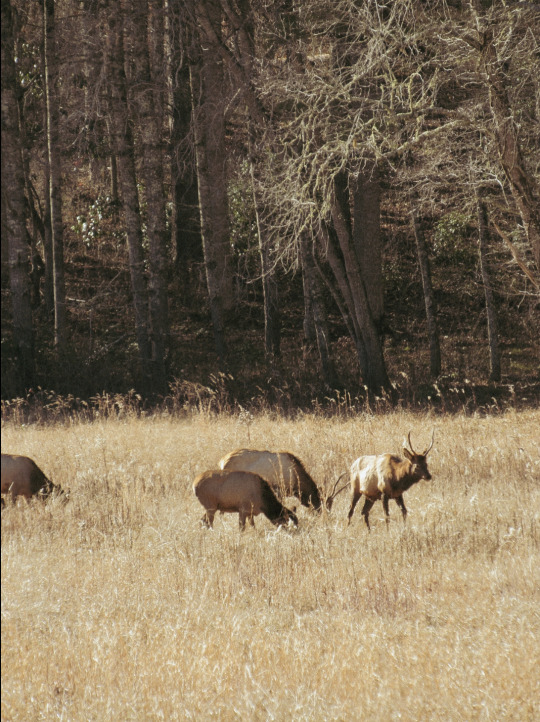
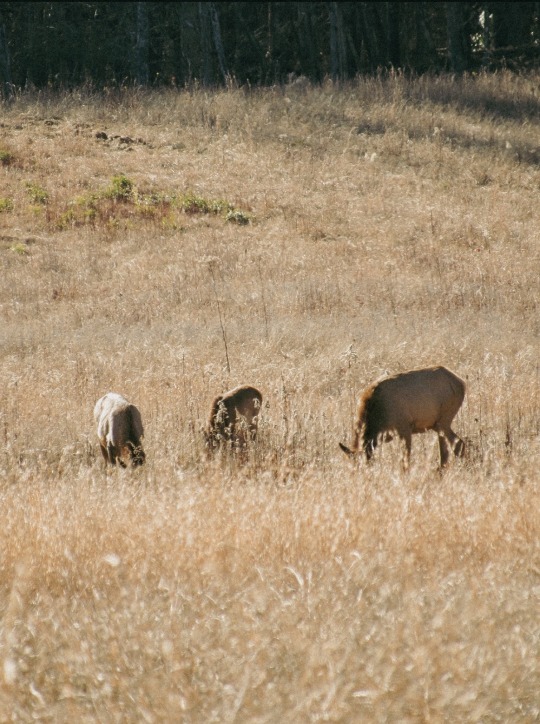
Elk in Cataloochee Valley, GSMNP, North Carolina
in 2001, 25 Elk were reintroduced in the Great Smoky Mountains National Park in NC by the National Park Service. As of 2023 the the NC Wildlife Commission estimate that there are between 150-200 Elk.
There used to be elk roaming Appalachian Mountains and other places in NC/Eastern US. By the 1700s they were extinct here due to over hunting and habitat loss.
My whole career focuses on conservation and education. I’ve worked mostly with species native to North American and North Carolina. I’ve been very interested in the conservation of endangered species since I was a little kid. It started with my dad telling me about the reasons for hunting seasons, and about all the animals we had in the area I lived. We’d spend a lot of time in the woods, fishing, hunting, exploring. I don’t hunt anymore but it’s how me got food so i’m not against it. Plus of the money that goes toward funding conservation comes from people who hunt/fish.
Anyways idk why i’m going on and on right now. I just really love conservation and I always have. Every time I go to the mountains and see the Elk I get the same excitement, joy, and wonder that I did when I was a kid. Some of my best memories are being in the mountains with my uncle exploring, learning about plants, animals, and my families roots. The older I get the more weird things tend to get with my family. Nature is always the one thing that brings some of them and me together.
#appalachain mountains#great smoky mountains#north carolina#tennessee#elk#wildlife#animals#conservation#woods#appalachia
3 notes
·
View notes
Photo

Carolina Jessamine in the NC woodlands... state flower of SC... pretty much poisonous to humans in all parts of the plant... also referred to as the Evening Trumpetflower... this vine is native to NC...
11 notes
·
View notes